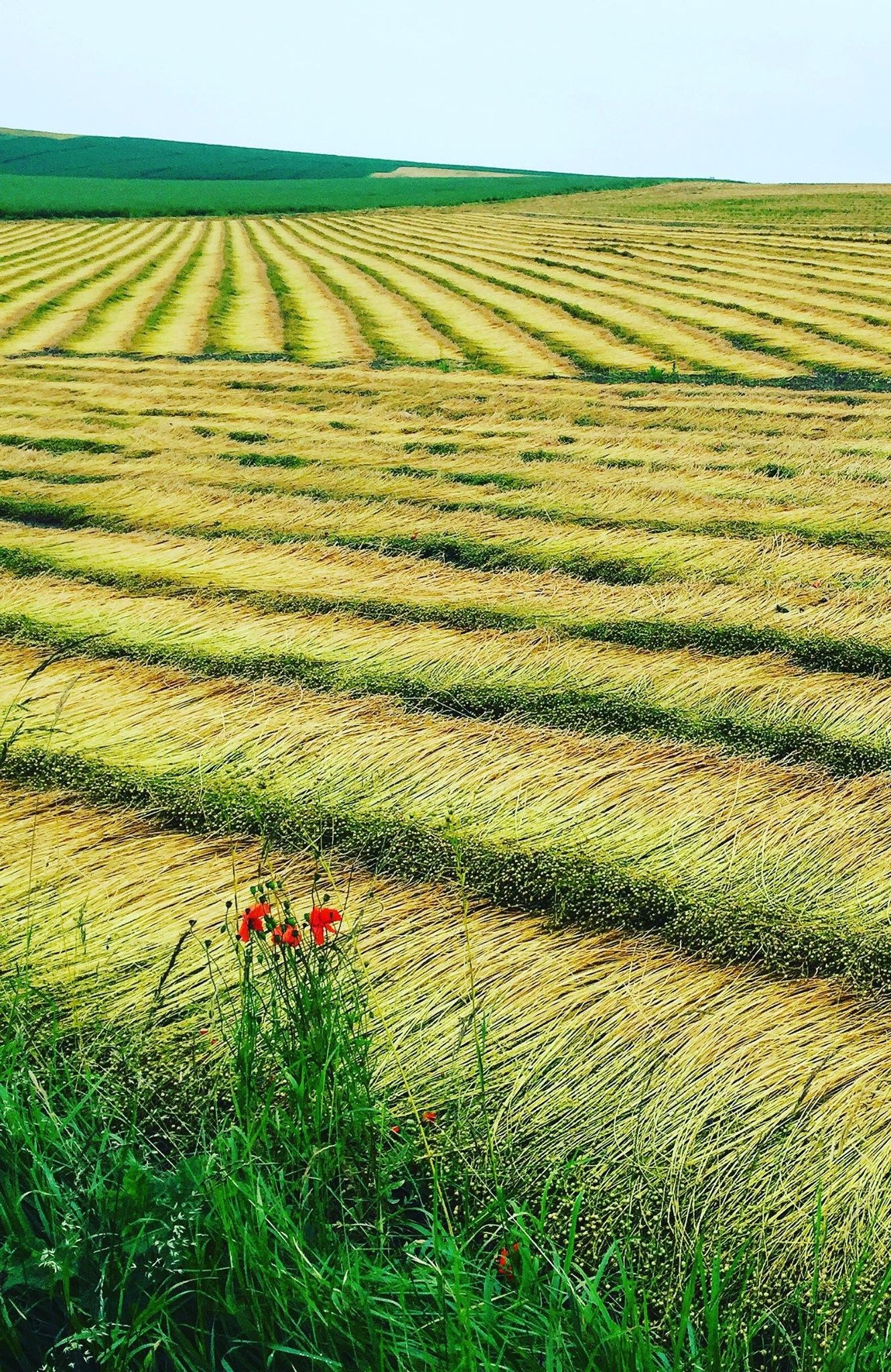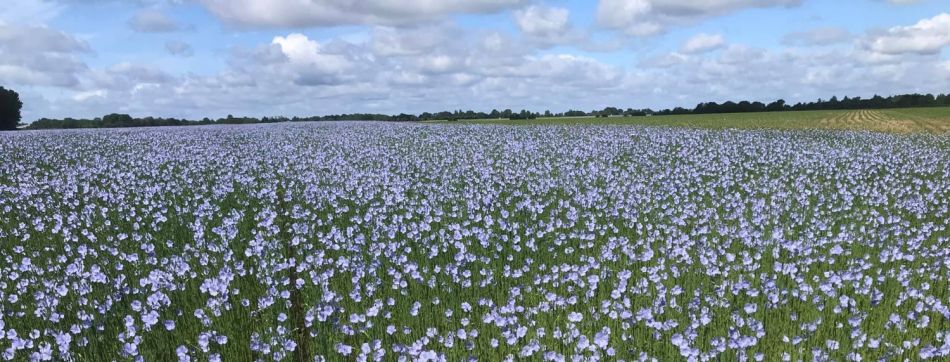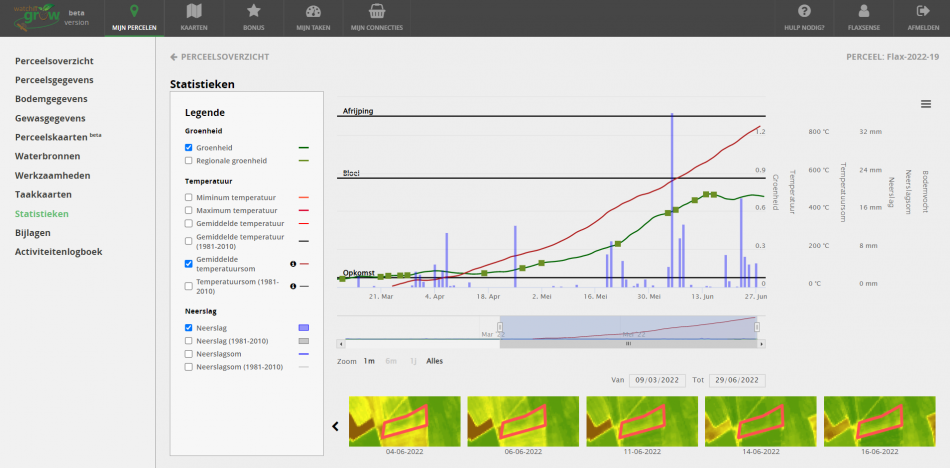Monitoring based on satellite imagery can also help flax growers to manage their plots, which are often very far spread. The existing WatchITgrow platform is being used and further expanded for the Flaxsense 2.0 project. This will allow flax growers to monitor their plots remotely. VITO is also involved in the expansion of the platform for flax cultivation. This project can count on great enthusiasm among Belgian flax growers. ‘A young generation that’s totally open to digital tools is ready.’
Flax cultivation is an atypical sector of agriculture. Because flax can only be cultivated every six or seven years on the same plot, most flax growers operate within a very wide radius of action. It is not unusual for their plots – which they generally lease from a farmer – to be dozens to even hundreds of kilometres away from each other. This means they cover a great many kilometres to monitor their crops in situ, so they may easily be travelling for several days in a week. This close monitoring is necessary, as flax has a short growth season (100 days) and is highly sensitive to variations in the soil.
Monitoring crops from space with precision agriculture
Several flax growers put the question of what precision agriculture could mean for their sector to the Flemish agricultural research centre Inagro a few years ago. And whether there was a way to limit their long journey times. Inagro dealt with the question in 2019 as part of a one-year project, along with ILVO, in which several flax plots were studied using satellite imagery. ‘We were able to distinguish a range of crop indicators that are useful to the flax growers,’ says Lies Willaert from Inagro. Following this, a fully-fledged project was then launched on digital monitoring of flax plots based on satellite imagery in 2021. Aside from Inagro and the General Belgian Flax Alliance (ABV), ILVO and of course VITO are also working on Flaxsense 2.0, which is being supported from VLAIO (as well as through the sectoral organisation BO Flax & Hemp).
VITO has years of knowledge and experience in the field of precision agriculture with remote sensing.
The Flaxsense 2.0 project will run for four years (2021 to 2025), which will allow it to monitor four flax growth cycles from space. ‘We monitor twenty plots every year. We search for links between what we see on the satellite imagery and what the flax growers are actually seeing in the field,’ says Isabelle Piccard from VITO. This involves indicators such as crop height, the quantity of biomass, crop stage, and so on.
Based on these indicators, flax growers decide when, where and how they should best intervene, for example with growth regulators – a homogeneous harvest is important for good-quality flax fibres, which makes constant growth necessary.
The results of this research and the adapted tools will shortly also be available via the WatchITgrow web platform, which VITO originally developed for potato cultivation. Flax growers will then be able to gain access to all the information relevant to them for smooth and efficient monitoring of their crops – and all this remotely.
Five flax growers are also closely involved in the project. After all, it is based on their input, literally from the field, that the links with the elements visible on the satellite imagery are calibrated. Willaert: ‘We’ve noticed that the flax growers are totally open to digital tools. These are often young people who are ready to take over their parents’ businesses.’ Our country has 45 active flax growers who manage plots spread across the entire (sandy) loam region that runs from Northern France through Belgium to the Netherlands – in this country, that includes around sixteen thousand hectares of flax ground.
The graph shows the course of the vegetation index or “greenness” (based on satellite images), rainfall and the temperature sum for a flax plot. Based on the temperature sum the development stage of the flax is also estimated (rise, bloom, ripening). At the bottom you see a series of available satellite images (vegetation index) for this plot.
A more sustainable and competitive flax crop
Dieter Vanovertveldt from flax company Debruyne from Ardooie is one of the flax growers taking part. He uses the adapted version of WatchITgrow to convey what he sees on his plots to the project’s researchers. ‘A method of doing more monitoring remotely is very welcome, as the journey times between the various plots can sometimes really add up. If I have more time for other work thanks to the adapted tool, then that’s worth it already.’
The adapted tool can also be very useful for timely interventions on the plots. Vanovertveldt: ‘The quality of the flax that we harvest is very important. Growth regulators are sometimes needed and proper timing is crucial to that.’
Flaxsense 2.0 will help to make the flax crop, which can almost be considered as heritage, more sustainable and also more competitive. Flax is a highly sustainable crop in itself, because it stores a great deal of carbon. The sector’s future looks bright in any case, as flax is being incorporated into more secondary applications beyond linen (the most typical application). ‘In recent times, we’ve been seeing a sharp rise in the value of the short flax fibre,’ says Véronique Standaert from the ABV. ‘This can also be used in textiles, as well as in construction products such as insulation materials and, of course, in flax fibres to reinforce composite materials – as an alternative to glass fibres. Then there’s naturally the well-known application in dollar bills too.’
Flax grower Vanovertveldt is focusing on short flax fibres as well. ‘These are just as strong as long glass fibres, but lighter, meaning they contribute less to the weight of composite materials. This is important in aircraft components, for example, meaning the aircraft consumes less fuel.’
The use of flax is not only more sustainable than with glass fibres or other natural fibres – the raw material also comes from here. This has already led to the introduction of a genuine quality label for flax cultivated and processed in Europe: European Flax. The fibre is processed today mainly in China and India. Within Europe the further processing of the fibre is also being set up again, so that all aspects from the cultivation up to processing can stay within Europe, which is very important for the further development on the level of sustainability.




